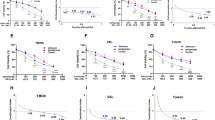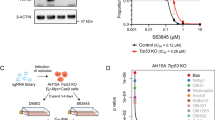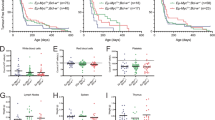Abstract
High-grade B-cell lymphoma with MYC and BCL2 and/or BCL6 rearrangements, mostly known as double-hit lymphoma (DHL), is a rare entity characterized by morphologic and molecular features between Burkitt lymphoma and the clinically manageable diffuse large B-cell lymphoma (DLBCL). DHL patients usually undergo a rapidly progressing clinical course associated with resistance to standard chemo-immunotherapy. As a consequence, the prognosis of this entity is particularly poor with a median overall survival inferior to 1 year. ABT-199 (venetoclax) is a potent and selective small-molecule antagonist of BCL-2 recently approved for the treatment of a specific subtype of lymphoid neoplasm. In this study, we demonstrate that single-agent ABT-199 efficiently displaces BAX from BCL-2 complexes but fails to maintain a significant antitumor activity over time in most MYC+/BCL2+DHL cell lines and primary cultures, as well as in a xenograft mouse model of the disease. We further identify the accumulation of the BCL2-like protein BFL-1 to be a major mechanism involved in acquired resistance to ABT-199. Noteworthy, this phenomenon can be counteracted by the BET bromodomain inhibitor CPI203, since gene expression profiling identifies BCL2A1, the BFL-1 coding gene, as one of the top apoptosis-related gene modulated by this compound. Upon CPI203 treatment, simultaneous downregulation of MYC and BFL-1 further overcomes resistance to ABT-199 both in vitro and in vivo, engaging synergistic caspase-mediated apoptosis in DHL cultures and tumor xenografts. Together, these findings highlight the relevance of BFL-1 in DH lymphoma-associated drug resistance and support the combined use of a BCL-2 antagonist and a BET inhibitor as a promising therapeutic strategy for patients with aggressive DHL.
This is a preview of subscription content, access via your institution
Access options
Subscribe to this journal
Receive 50 print issues and online access
$259.00 per year
only $5.18 per issue
Buy this article
- Purchase on Springer Link
- Instant access to full article PDF
Prices may be subject to local taxes which are calculated during checkout





Similar content being viewed by others
References
Aukema SM, Siebert R, Schuuring E, van Imhoff GW, Kluin-Nelemans HC, Boerma EJ, et al. Double-hit B-cell lymphomas. Blood. 2011;117:2319–31.
Drexler HG, Eberth S, Nagel S, MacLeod RA. Malignant hematopoietic cell lines: in vitro models for double-hit B-cell lymphomas. Leuk Lymphoma. 2016;57:1015–20.
Anderson MA, Tsui A, Wall M, Huang DCS, Roberts AW, Current challenges and novel treatment strategies in double hit lymphomas. Ther Adv Hematol. 2016;7:52–64.
Li S, Lin P, Young KH, Kanagal-Shamanna R, Yin CC, Medeiros LJ, MYC/BCL2 double-hit high-grade B-cell lymphoma. Adv Anat Pathol. 2013;20:315–26.
Turakhia SK, Hill BT, Dufresne SD, Nakashima MO, Cotta CV, Aggressive B-cell lymphomas with translocations involving BCL6 and MYC have distinct clinical-pathologic characteristics. Am J Clin Pathol. 2014;142:339–46.
Xu X, Zhang L, Wang Y, Zhang Q, Zhang L, Sun B, et al. Double-hit and triple-hit lymphomas arising from follicular lymphoma following acquisition of MYC: report of two cases and literature review. Int J Clin Exp Pathol. 2013;6:788–94.
Swerdlow SH, Campo E, Pileri SA, Harris NL, Stein H, Siebert R, et al. The 2016 revision of the World Health Organization classification of lymphoid neoplasms. Blood. 2016;127:2375–90.
Rosenwald A, Wright G, Chan WC, Connors JM, Campo E, Fisher RI, et al. The use of molecular profiling to predict survival after chemotherapy for diffuse large-B-cell lymphoma. N Engl J Med. 2002;346:1937–47.
Pfreundschuh M, Trumper L, Osterborg A, Pettengell R, Trneny M, Imrie K, et al. CHOP-like chemotherapy plus rituximab versus CHOP-like chemotherapy alone in young patients with good-prognosis diffuse large-B-cell lymphoma: a randomised controlled trial by the MabThera International Trial (MInT) Group. Lancet Oncol. 2003;7:379–91.
Green TM, Young KH, Visco C, Xu-Monette ZY, Orazi A, Go RS, et al. Immunohistochemical double-hit score is a strong predictor of outcome in patients with diffuse large B-cell lymphoma treated with rituximab plus cyclophosphamide, doxorubicin, vincristine, and prednisone. J Clin Oncol. 2012;30:3460–7.
Snuderl M, Kolman OK, Chen YB, Hsu JJ, Ackerman AM, Dal CP, et al. B-cell lymphomas with concurrent IGH-BCL2 and MYC rearrangements are aggressive neoplasms with clinical and pathologic features distinct from Burkitt lymphoma and diffuse large B-cell lymphoma. Am J Surg Pathol. 2010;34:327–40.
Karube K, Campo E, MYC alterations in diffuse large B-cell lymphomas. Semin Hematol. 2015;52:97–106.
Devaiah BN, Gegonne A, Singer DS, Bromodomain 4: a cellular Swiss army knife. J Leukoc Biol. 2016;100:679–86.
Dey A, Chitsaz F, Abbasi A, Misteli T, Ozato K, The double bromodomain protein Brd4 binds to acetylated chromatin during interphase and mitosis. Proc Natl Acad Sci USA. 2003;100:8758–63.
Rodriguez RM, Huidobro C, Urdinguio RG, Mangas C, Soldevilla B, Dominguez G, et al. Aberrant epigenetic regulation of bromodomain BRD4 in human colon cancer. J Mol Med (Berl). 2012;90:587–95.
Segura MF, Fontanals-Cirera B, Gaziel-Sovran A, Guijarro MV, Hanniford D, Zhang G, et al. BRD4 sustains melanoma proliferation and represents a new target for epigenetic therapy. Cancer Res. 2013;73:6264–76.
Chaidos A, Caputo V, Karadimitris A, Inhibition of bromodomain and extra-terminal proteins (BET) as a potential therapeutic approach in haematological malignancies: emerging preclinical and clinical evidence. Ther Adv Hematol. 2015;6:128–41.
Delmore JE, Issa GC, Lemieux ME, Rahl PB, Shi J, Jacobs HM, et al. BET bromodomain inhibition as a therapeutic strategy to target c-Myc. Cell. 2011;146:904–17.
Filippakopoulos P, Qi J, Picaud S, Shen Y, Smith WB, Fedorov O, et al. Selective inhibition of BET bromodomains. Nature. 2010;468:1067–73.
Mertz JA, Conery AR, Bryant BM, Sandy P, Balasubramanian S, Mele DA, et al. Targeting MYC dependence in cancer by inhibiting BET bromodomains. Proc Natl Acad Sci USA. 2011;108:16669–74.
King B, Trimarchi T, Reavie L, Xu L, Mullenders J, Ntziachristos P, et al. The ubiquitin ligase FBXW7 modulates leukemia-initiating cell activity by regulating MYC stability. Cell. 2013;153:1552–66.
Moros A, Rodriguez V, Saborit-Villarroya I, Montraveta A, Balsas P, Sandy P, et al. Synergistic antitumor activity of lenalidomide with the BET bromodomain inhibitor CPI203 in bortezomib-resistant mantle cell lymphoma. Leukemia. 2014;28:2049–59.
Siegel MB, Liu SQ, Davare MA, Spurgeon SE, Loriaux MM, Druker BJ, et al. Small molecule inhibitor screen identifies synergistic activity of the bromodomain inhibitor CPI203 and bortezomib in drug resistant myeloma. Oncotarget. 2015;6:18921–32.
Czabotar PE, Lessene G, Strasser A, Adams JM, Control of apoptosis by the BCL-2 protein family: implications for physiology and therapy. Nat Rev Mol Cell Biol. 2014;15:49–63.
Roberts AW, Seymour JF, Brown JR, Wierda WG, Kipps TJ, Khaw SL, et al. Substantial susceptibility of chronic lymphocytic leukemia to BCL2 inhibition: results of a phase I study of navitoclax in patients with relapsed or refractory disease. J Clin Oncol. 2012;30:488–96.
Cang S, Iragavarapu C, Savooji J, Song Y, Liu D, ABT-199 (venetoclax) and BCL-2 inhibitors in clinical development. J Hematol Oncol. 2015;8:129
Brown JR, Porter DL, O’Brien SM. Novel treatments for chronic lymphocytic leukemia and moving forward. Am Soc Clin Oncol Educ Book. 2014;34:e317–25.
Davids MS, Roberts AW, Seymour JF, Pagel JM, Kahl BS, Wierda WG, et al. Phase I first-in-human study of Venetoclax in patients with relapsed or refractory non-Hodgkin lymphoma. J Clin Oncol. 2017;35:826–33.
Souers AJ, Leverson JD, Boghaert ER, Ackler SL, Catron ND, Chen J, et al. ABT-199, a potent and selective BCL-2 inhibitor, achieves antitumor activity while sparing platelets. Nat Med. 2013;19:202–8.
Roberts AW, Davids MS, Pagel JM, Kahl BS, Puvvada SD, Gerecitano JF, et al. Targeting BCL2 with Venetoclax in relapsed chronic lymphocytic leukemia. N Engl J Med. 2016;374:311–22.
Fresquet V, Rieger M, Carolis C, Garcia-Barchino MJ, Martinez-Climent JA, Acquired mutations in BCL2 family proteins conferring resistance to the BH3 mimetic ABT-199 in lymphoma. Blood. 2014;123:4111–9.
Yecies D, Carlson NE, Deng J, Letai A, Acquired resistance to ABT-737 in lymphoma cells that up-regulate MCL-1 and BFL-1. Blood. 2010;115:3304–3013.
Fan G, Simmons MJ, Ge S, Dutta-Simmons J, Kucharczak J, Ron Y, et al. Defective ubiquitin-mediated degradation of antiapoptotic Bfl-1 predisposes to lymphoma. Blood. 2010;115:3559–69.
Oppermann S, Ylanko J, Shi Y, Hariharan S, Oakes CC, Brauer PM, et al. High-content screening identifies kinase inhibitors that overcome venetoclax resistance in activated CLL cells. Blood. 2016;128:934–47.
Conery AR, Centore RC, Spillane KL, Follmer NE, Bommi-Reddy A, Hatton C, et al. Preclinical anticancer efficacy of BET bromodomain inhibitors is determined by the apoptotic response. Cancer Res. 2016;76:1313–9.
Ceribelli M, Kelly PN, Shaffer AL, Wright GW, Xiao W, Yang Y, et al. Blockade of oncogenic IkappaB kinase activity in diffuse large B-cell lymphoma by bromodomain and extraterminal domain protein inhibitors. Proc Natl Acad Sci USA. 2014;111:11365–70.
Certo M, Del Gaizo Moore V, Nishino M, Wei G, Korsmeyer S, Armstrong SA, et al. Mitochondria primed by death signals determine cellular addiction to antiapoptotic BCL-2 family members. Cancer Cell. 2006;9:351–65.
Johnson-Farley N, Veliz J, Bhagavathi S, Bertino JR. ABT-199, a BH3 mimetic that specifically targets Bcl-2, enhances the antitumor activity of chemotherapy, bortezomib and JQ1 in G double hitGÇØ lymphoma cells. Leuk Lymphoma. 2015;56:2146–52.
Bose P, Gandhi V, Konopleva M. Pathways and mechanisms of venetoclax resistance. Leuk Lymphoma. 2017;58:1–17.
Li L, Pongtornpipat P, Tiutan T, Kendrick SL, Park S, Persky DO, et al. Synergistic induction of apoptosis in high-risk DLBCL by BCL2 inhibition with ABT-199 combined with pharmacologic loss of MCL1. Leukemia. 2015;29:1702–12.
Niu X, Zhao J, Ma J, Xie C, Edwards H, Wang G, et al. Binding of released Bim to Mcl-1 is a mechanism of intrinsic resistance to ABT-199 which can be overcome by combination with Daunorubicin or Cytarabine in AML cells. Clin Cancer Res. 2016;22:4440–51.
Vandenberg CJ, Cory S, ABT-199, a new Bcl-2-specific BH3 mimetic, has in vivo efficacy against aggressive Myc-driven mouse lymphomas without provoking thrombocytopenia. Blood. 2016;121:2285–8.
Grygorowicz MA, Borycka IS, Nowak E, Paszkiewicz-Kozik E, Rymkiewicz G, Blachnio K, et al. Lenalidomide potentiates CD4+CD25+Treg-related suppression of lymphoma B-cell proliferation. Clin Exp Med. 2016;17:193–207.
Kawano Y, Kobune M, Yamaguchi M, Nakamura K, Ito Y, Sasaki K, et al. Ex vivo expansion of human umbilical cord hematopoietic progenitor cells using a coculture system with human telomerase catalytic subunit (hTERT)-transfected human stromal cells. Blood. 2003;101:532–40.
Perez-Galan P, Roue G, Lopez-Guerra M, Nguyen M, Villamor N, Montserrat E, et al. BCL-2 phosphorylation modulates sensitivity to the BH3 mimetic GX15-070 (Obatoclax) and reduces its synergistic interaction with bortezomib in chronic lymphocytic leukemia cells. Leukemia. 2008;22:1712–20.
Roue G, Perez-Galan P, Mozos A, Lopez-Guerra M, Xargay-Torrent S, Rosich L, et al. The Hsp90 inhibitor IPI-504 overcomes bortezomib resistance in mantle cell lymphoma in vitro and in vivo by down-regulation of the prosurvival ER chaperone BiP/Grp78. Blood. 2011;117:1270–9.
Acknowledgements
The authors thank Jocabed Roldan, Laura Jimenez, and Sandra Cabezas for expert technical assistance. This work was financially supported by Fondo de Investigación Sanitaria PI12/01847 and PI15/00102 (to G.R.), PI12/01536 (to A.L.-G.), European Regional Development Fund (ERDF) “Una manera de hacer Europa”, Redes Temáticas de Investigación Cooperativa de Cáncer from the Instituto de Salud Carlos III RD12/0036/0004 (to D.C.) and RD12/0036/0039 (to E.C.) and Generalitat de Catalunya 2014SGR346 (to D.C.) and 2014SGR795 (to E.C.). A.E.-A. was recipient of a predoctoral fellowship from Ministerio de Ciencia e Innovación (FPU). A.C.-J. holds a postdoctoral fellowship from The Agency for Management of University and Research (AGAUR, Beatriu de Pinós 2014 BP-B00177). This work was carried out at the Esther Koplowitz Center, Barcelona, under the CERCA Program (Generalitat de Catalunya).
Author contributions
A.E.-A. and J.G.V. designed study, performed experiments, analyzed data, and co‐wrote the manuscript. A.C.-J., D.G., and I.D. were in charge of and/or provided support to cell line transfection, western blot assay, flow cytometry analysis, and interpretation of the data. V.R. provided support in animal studies. I.S. supervised cell line authentication. E.C. and D.C. reviewed the manuscript. A.M. helped in designing immunohistochemical assays. G.Ry. provided essential primary samples. P.P.-G. helped in interpreting the results and reviewed the manuscript. A.L.-G. co-designed the study and reviewed the manuscript. G.Ro. conceived and designed the study, analyzed data, interpreted the results, and wrote the manuscript.
Author information
Authors and Affiliations
Corresponding author
Ethics declarations
Conflict of interests
The authors declare that they have no competing interests.
Electronic supplementary material
Rights and permissions
About this article
Cite this article
Esteve-Arenys, A., Valero, J.G., Chamorro-Jorganes, A. et al. The BET bromodomain inhibitor CPI203 overcomes resistance to ABT-199 (venetoclax) by downregulation of BFL-1/A1 in in vitro and in vivo models of MYC+/BCL2+ double hit lymphoma. Oncogene 37, 1830–1844 (2018). https://doi.org/10.1038/s41388-017-0111-1
Received:
Revised:
Accepted:
Published:
Issue Date:
DOI: https://doi.org/10.1038/s41388-017-0111-1
This article is cited by
-
Bromodomain and extraterminal (BET) proteins: biological functions, diseases, and targeted therapy
Signal Transduction and Targeted Therapy (2023)
-
Altered pathways and targeted therapy in double hit lymphoma
Journal of Hematology & Oncology (2022)
-
BCL2A1 regulates Canady Helios Cold Plasma-induced cell death in triple-negative breast cancer
Scientific Reports (2022)
-
A redox switch regulates the structure and function of anti-apoptotic BFL-1
Nature Structural & Molecular Biology (2020)
-
Genetic characterization of ABT-199 sensitivity in human AML
Leukemia (2020)



